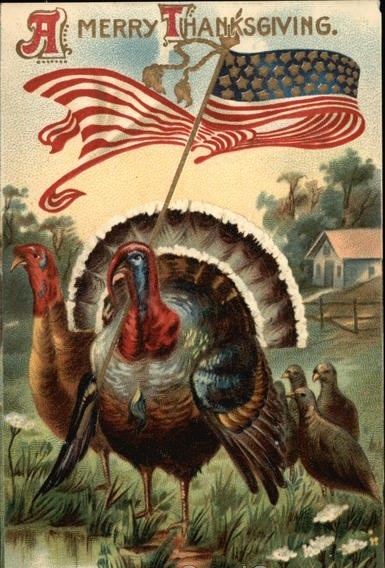
A patriotic turkey family in a postcard from about 1900. Image from the Library of Congress.
I was in the grocery store the other day looking at the displays of all the edibles and drinkables I am supposed to buy for Thanksgiving. Turkey, cornbread stuffing, pumpkin pie, cranberries, sweet and mashed potatoes, gravy, Beans or Brussel sprouts, and, of course, dinner rolls. Is there any other holiday with so many prescribed foods? Actually, is there any other holiday with so many associated myths—about the food at the 1621 meal, the Mayflower, Plymouth rock, the “Pilgrims,” the “Indians,” and the lovely cross-cultural experience they had eating together.
After over 400 years, there’s much more Thanksgiving fiction than there is fact, and separating them is like trying to keep cranberry sauce from running into the mashed potatoes. Fortunately, an article by Megan Gambino in the November 21, 2011 Smithsonian Magazine discusses what we know or can surmise about the actual menu, and a recent book (This Land Is Their Land: The Wampanoag Indians, Plymouth Colony, and the Troubled History of Thanksgiving, by David Silverman) demonstrates that, long before Abraham Lincoln made Thanksgiving a national holiday in 1863, the story of the Plymouth settlers and their Wampanoag guests had been extensively elaborated upon in order to put the best spin on the United States’ history of colonization.
The only participant description of the meal is in a letter dated December 11, 1621, from Plymouth colonist Edward Winslow to a friend. Winslow reports that the colonists recently feasted for three days to celebrate their first good crops of barley, the seeds of which they brought with them from Europe, and of the corn the local Wampanoag people had introduced to them. He doesn’t mention eating turkey at the meal, though they were present in the area, but he notes that they dined on duck and goose, and the venison that the Wampanoag had contributed. In addition, there was probably seafood on the table since Winslow remarks that fish were abundant in Plymouth, boasting that, “In the autumn, we can take a barrel of eels in one night.”
That’s pretty much all the hard data we have about the harvest meal. The harvested corn would have been dried and the kernels cracked and ground for use in corn meal mush or cornbread. The corn could also be boiled up with a dried common bean (something like kidney or lima) to become succotash. That name came from a Narragansett (neighbors of the Wampanoag) word meaning “broken corn kernels.” The succotash of 1621 bore little resemblance to modern versions with various colorful and delicious fresh vegetables.
There would have been pumpkin or squash in some form, probably stewed, but certainly not in a pie as no one in Plymouth had wheat flour for a crust. Or for dinner rolls. Cranberries were used by the Native Americans in the area, but lacking access to enough sweetener to make the acidic bog berries palatable, they usually mixed them into pemmican. Blueberries, which were plentiful, would have been a much more likely addition to the menu. Neither potatoes nor sweet potatoes had made it from South America to New England by 1621. Ditto for yams, which came to the Americas from West Africa in conjunction with the slave trade.
Turkey claimed pride of place on our Thanksgiving dinner tables through the interweaving of much fiction with the few facts. Most important was the fiction of Sarah Josepha Hale, whose 1827 novel, Northwood: Or a Tale of New England, devoted an entire chapter to an appetizing description of a “traditional Thanksgiving dinner” with a “roasted turkey at the head of the table accompanied by gravy, savory stuffing, and pumpkin pie.” Little known today, Hale was prominent as a writer and the editor, from 1837 to 1877, of the most widely circulated U.S. magazine, Godey’s Lady’s Book. As an important arbiter of taste and values, Hale used her influence to campaign tirelessly for a national Thanksgiving holiday, which she believed would unify the country as it drifted toward a civil war. Unfortunately, it didn’t work out that way but, after Union victories at Gettysburg and Vicksburg, President Lincoln was feeling thankful enough to make the holiday official. Once that happened, Godey’s had all the Thanksgiving recipes homemakers needed.
The Kelley House Museum is open from 11AM to 3PM Thursday through Monday. If you have a question for the curator, reach out to curator@kelleyhousemuseum.org to make an appointment. Walking tours of the historic district depart from the Kelley House regularly.